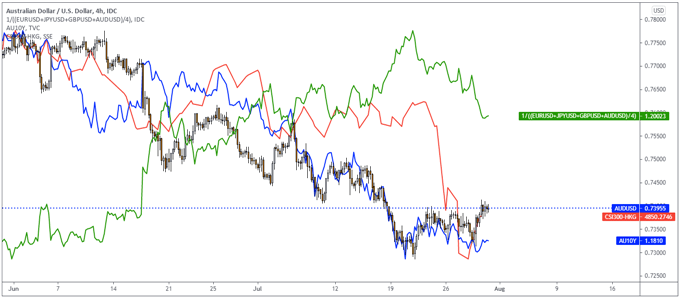Australian Dollar Fundamental Forecast: Bearish
- Australian Dollar slowed its broader descent but remains vulnerable
- Dovish RBA, surging Covid cases, Beijing crackdowns threaten AUD
- Softer US non-farm payrolls data may offer upside relief to AUD/USD



The Australian Dollar spent most of its time last week slowly gaining ground against some of its major counterparts, but progress was fairly lackluster. For AUD/USD though, it meant a material pause in what has been a top that has seen prices decline over 7.5% since February. Underlying fundamental dynamics are undermining the outlook, and the road in the week ahead likely remains bumpy for the Aussie.
All eyes are on the Reserve Bank of Australia (RBA) interest rate decision, where the central bank is likely to keep key tool settings unchanged. The RBA partially trimmed bond purchases at its last meeting, but the recent surge in local Covid cases amid the highly contagious Delta variant could hinder economic growth prospects. If that means a more dovish central bank for longer, then the Australian Dollar could be vulnerable.
This is as Australia’s state of New South Wales reported record cases, with health experts noting that lockdowns could be here for longer. Sydney could reintroduce restrictions as well amid surging cases. Moreover, this is not just isolated to Australia, but parts of the Asia-Pacific region, North America and Europe. If lockdowns threaten global growth, then the commodity-linked Australian Dollar could be vulnerable.
RBA Governor Philip Lowe will be testifying before a Parliament committee at the end of the week. If he reiterates these near-term risks, potentially sending Australian government bond yields lower, then that may compound Aussie weakness. In fact, AUD/USD has been closely following a decline in Australian bond yields and Chinese equities as of late – see chart below.
Beijing’s crackdown on the technology and education sectors have fueled panic, sending many investors liquidating their positions in Chinese and Hong Kong shares. With profitability being increasingly at risk, that could lead to slower growth in the world’s second-largest economy. China just so happens to be Australia’s largest trading partner, and a slowdown in the former could risk reverberating into the latter.
The week will also wrap up with US non-farm payrolls data, with the world’s largest economy expected to add 925k jobs in July, up from 850k prior. The unemployment rate is also expected to decline to 5.6% from 5.9% prior. Economists are now seemingly overestimating the health and vigor of the economy, opening the door to a disappointing print. If that further pushes out Fed tapering bets, then AUD/USD could see strength.



AUD/USD Versus US Dollar Index, CSI 300 and Australian 10-Year Government Bond Yields

Chart Created Using TradingView
--- Written by Daniel Dubrovsky, Strategist for DailyFX.com
To contact Daniel, use the comments section below or @ddubrovskyFX on Twitter




